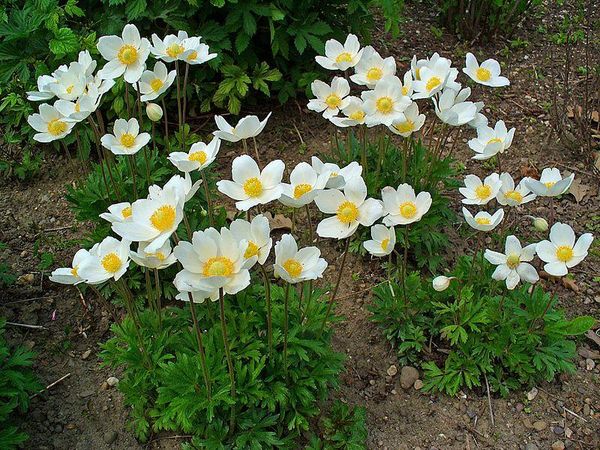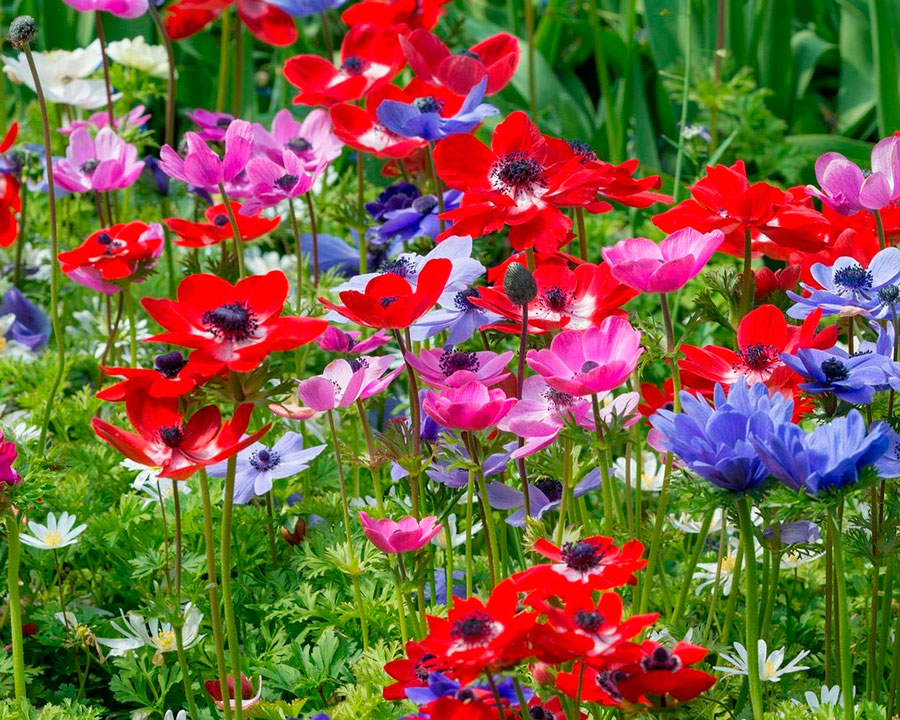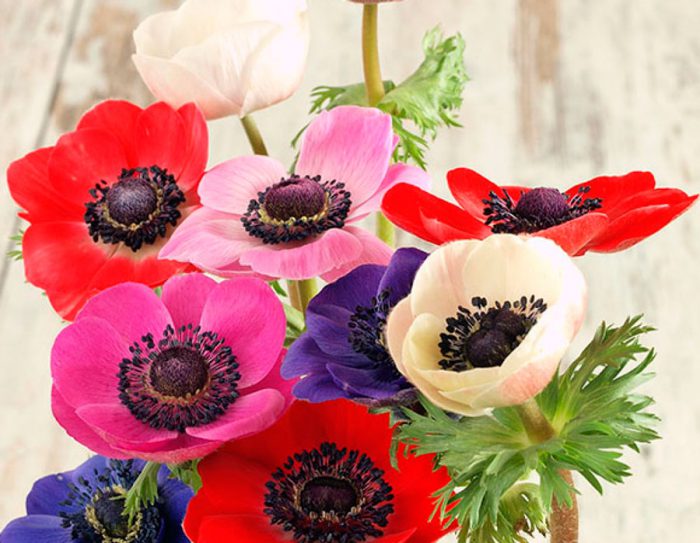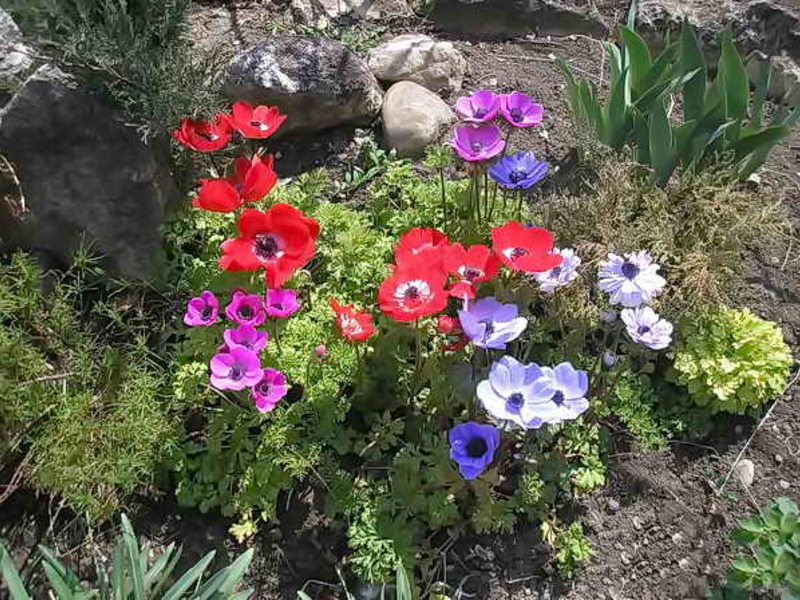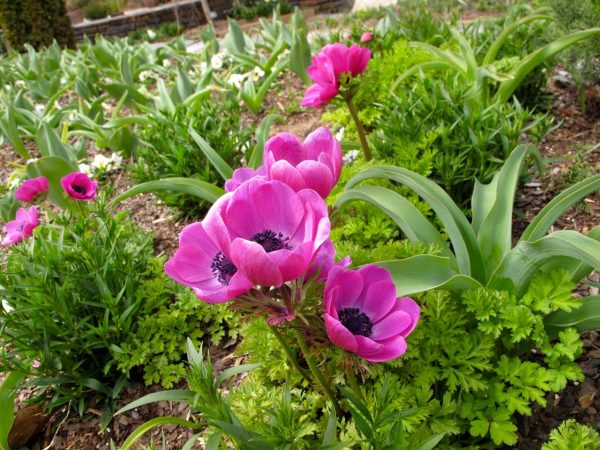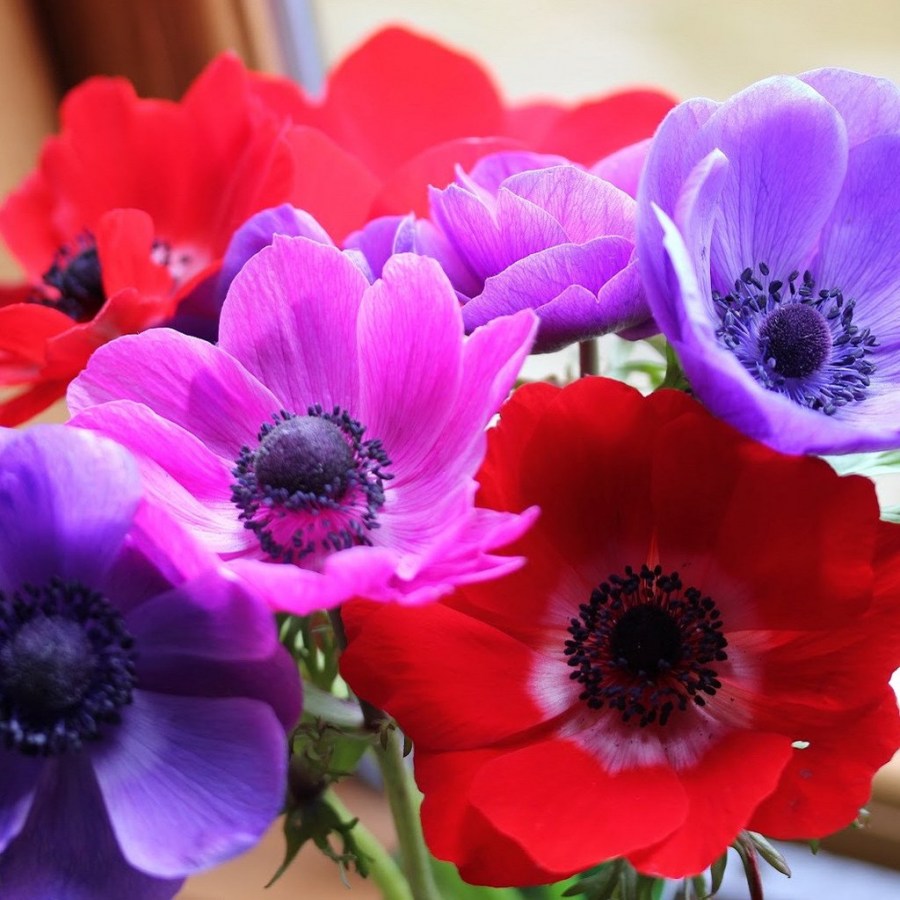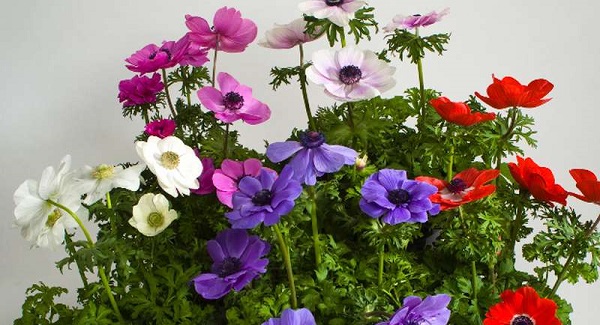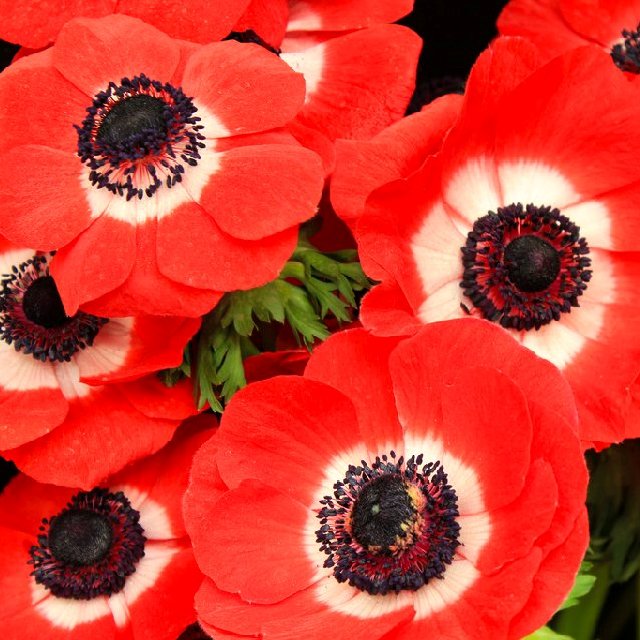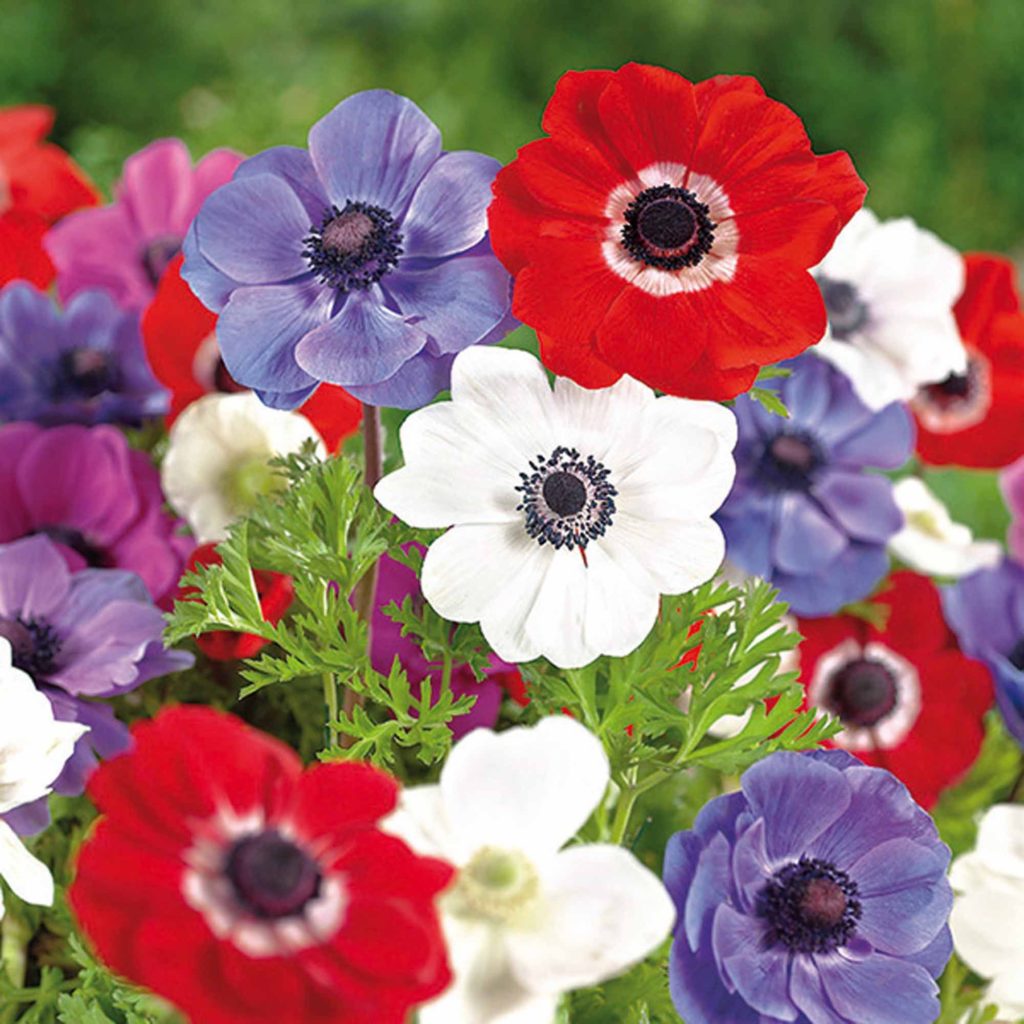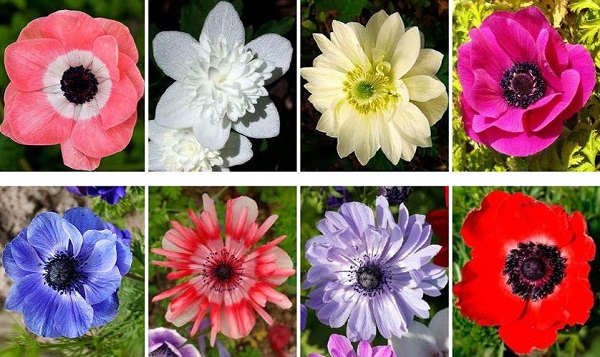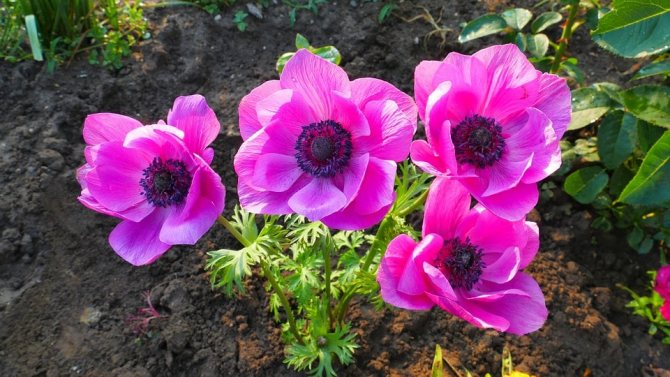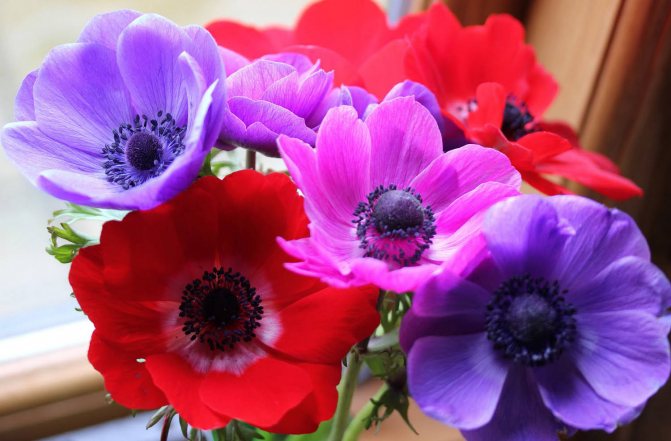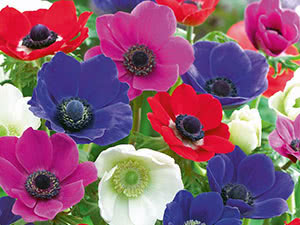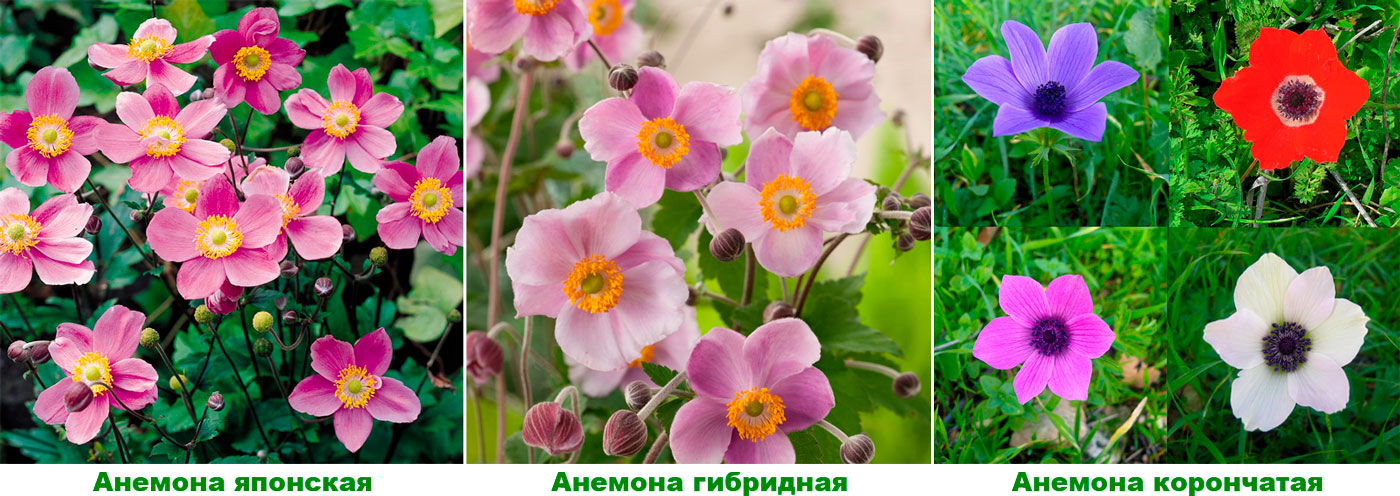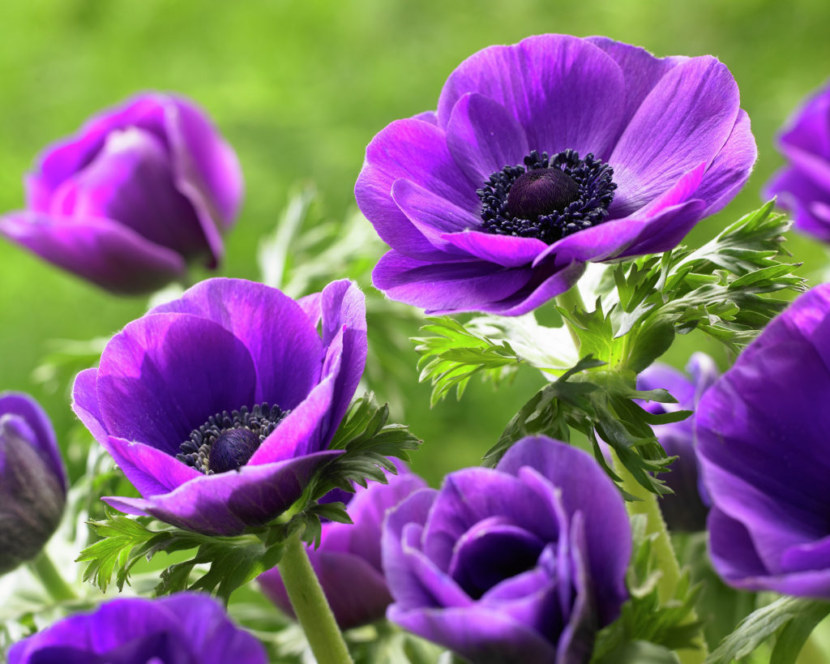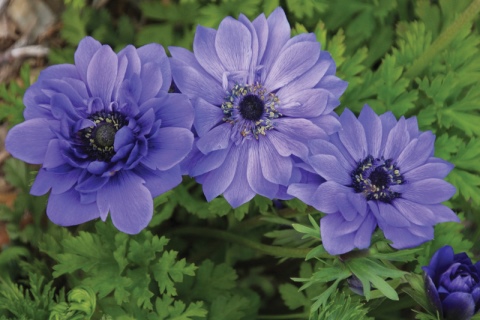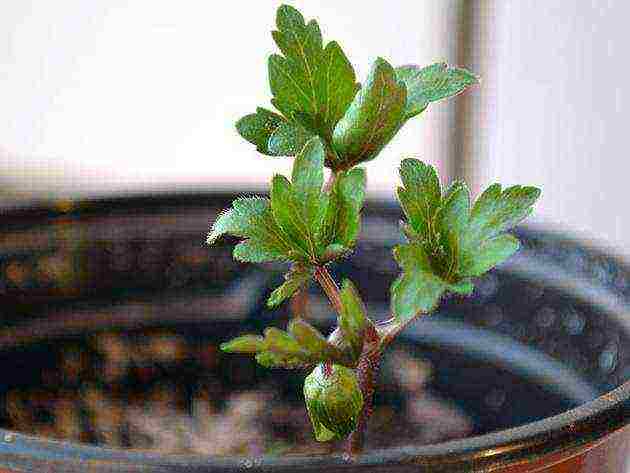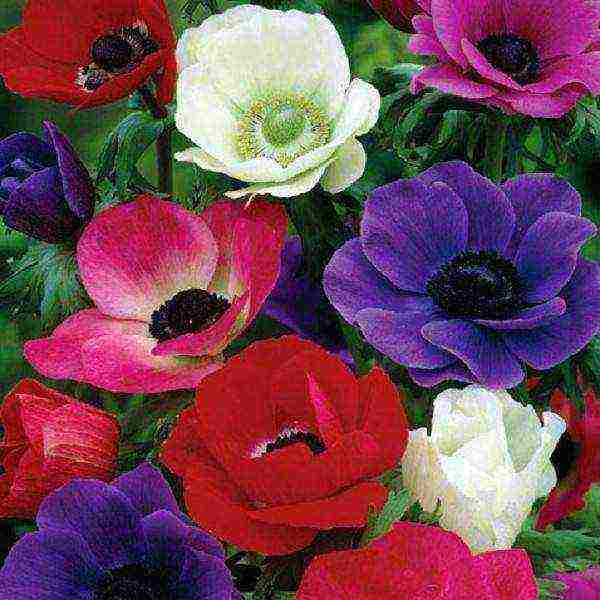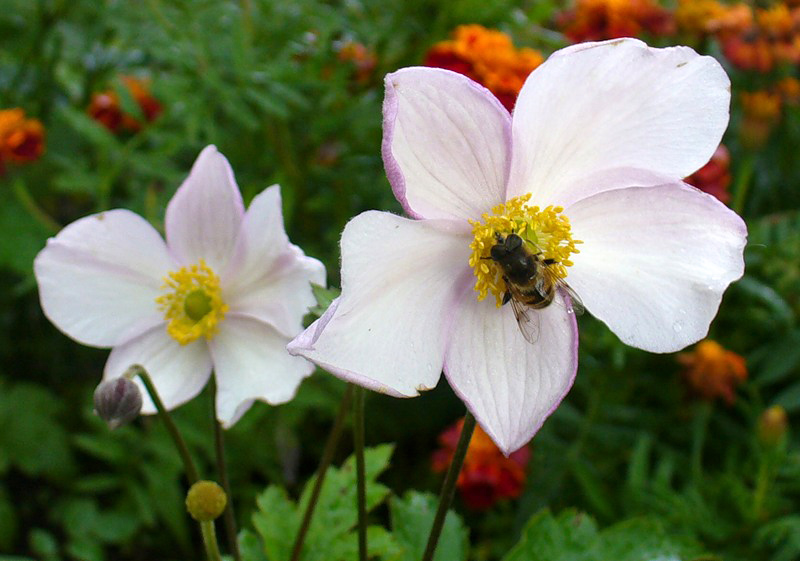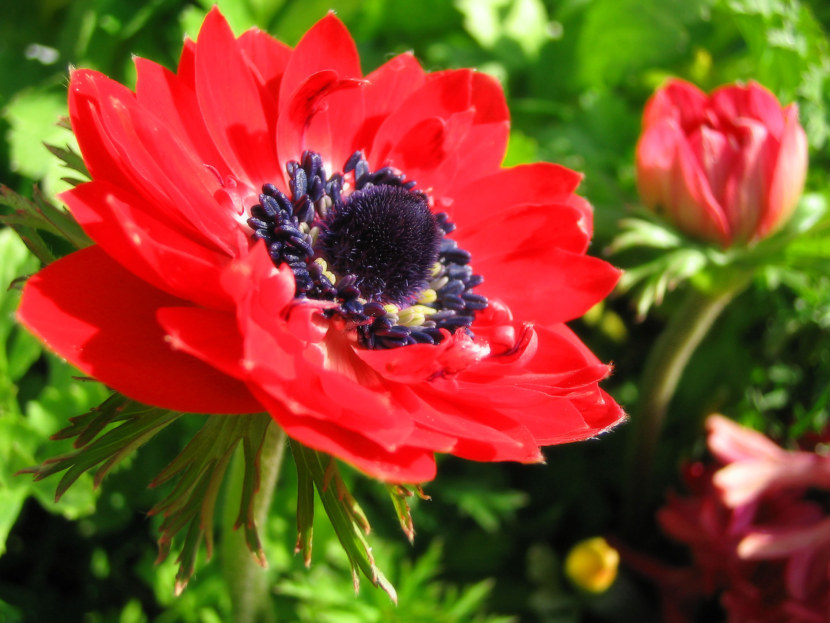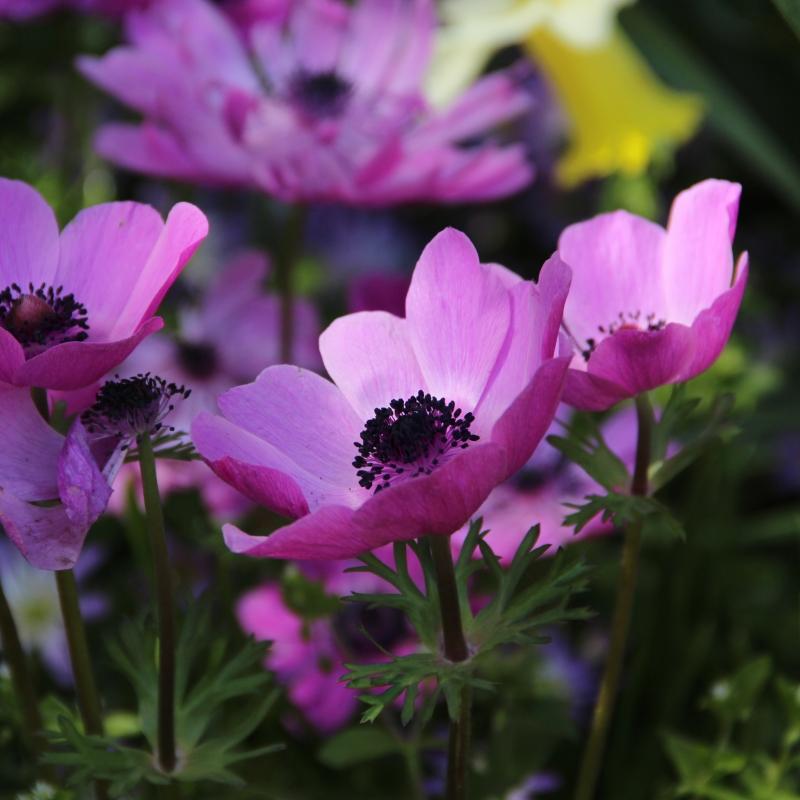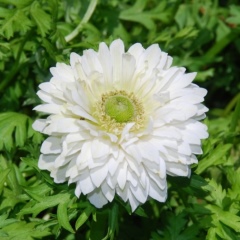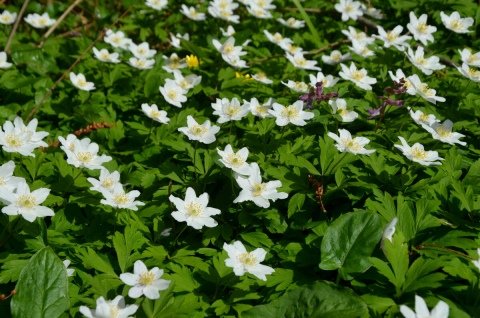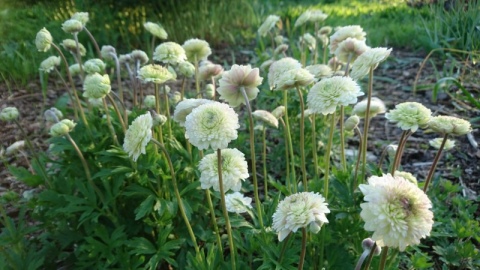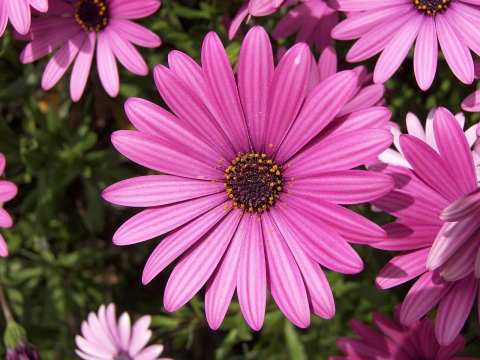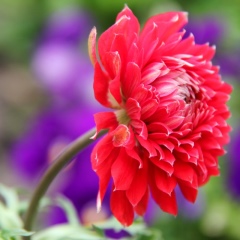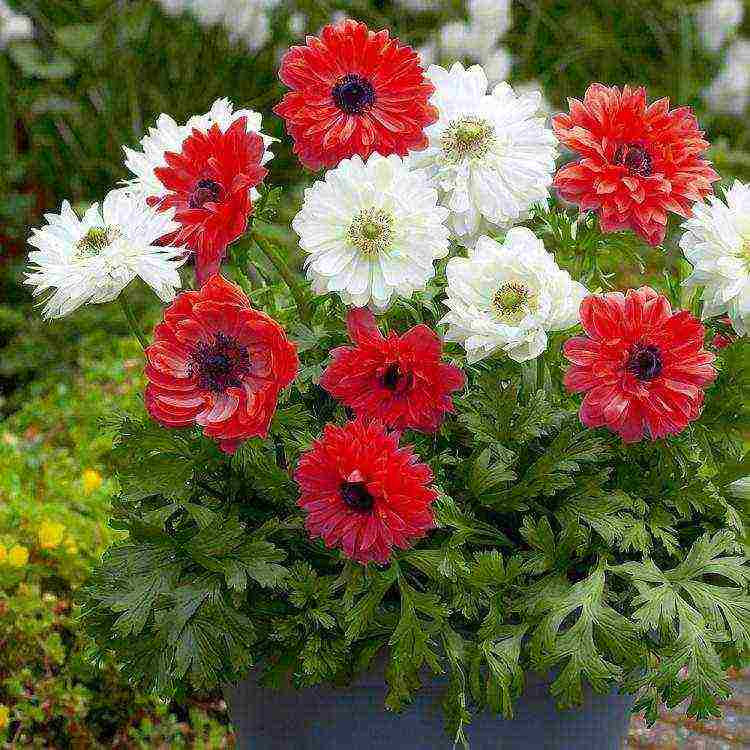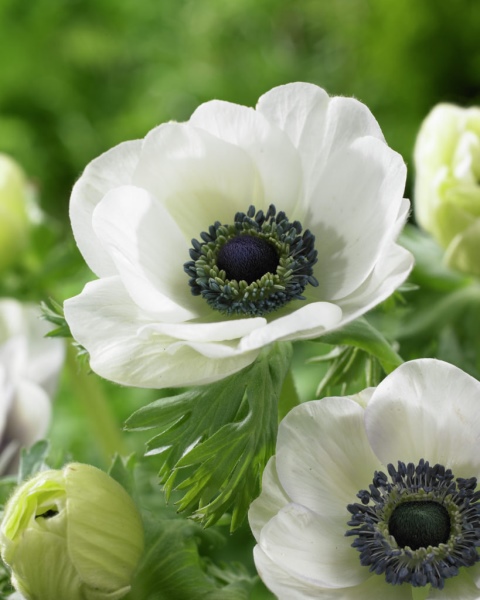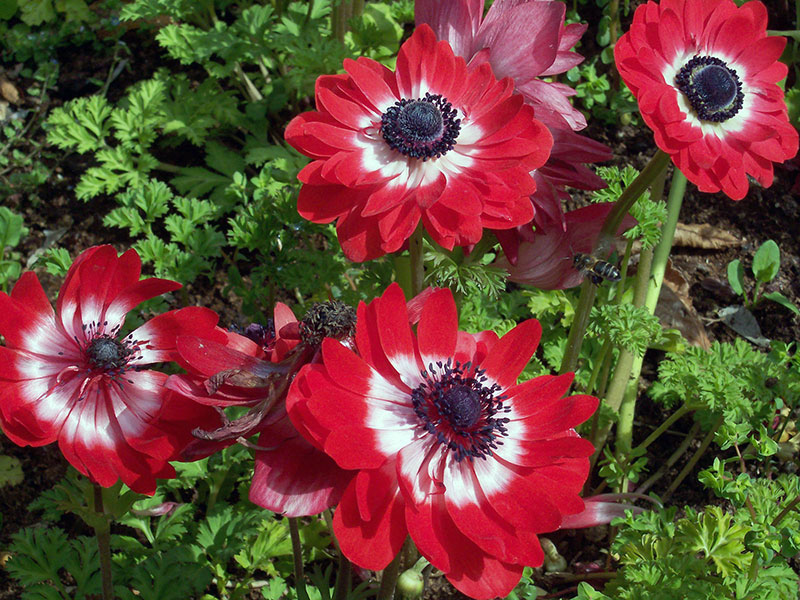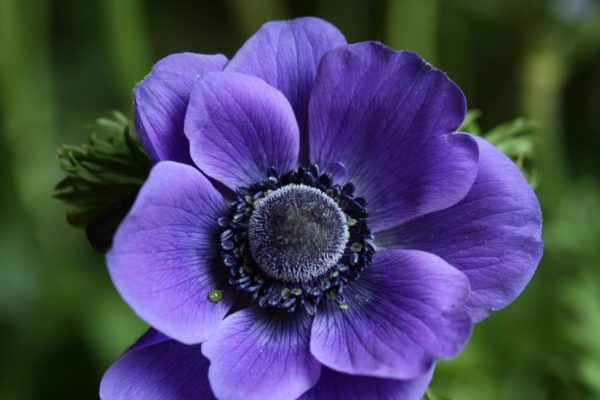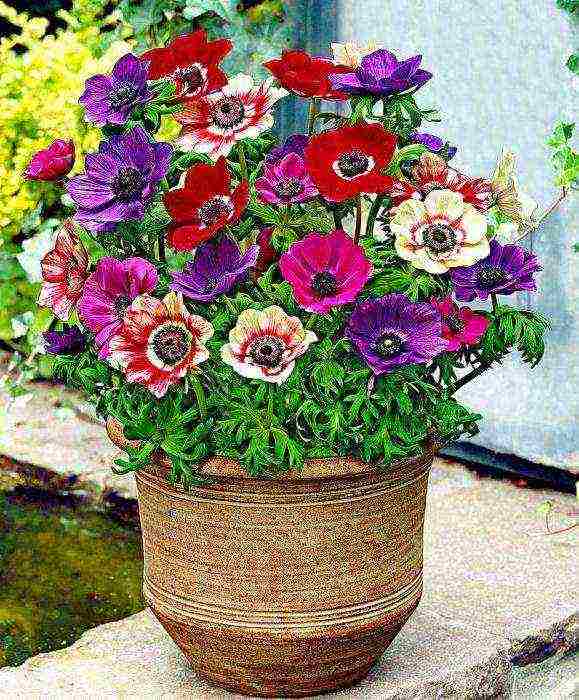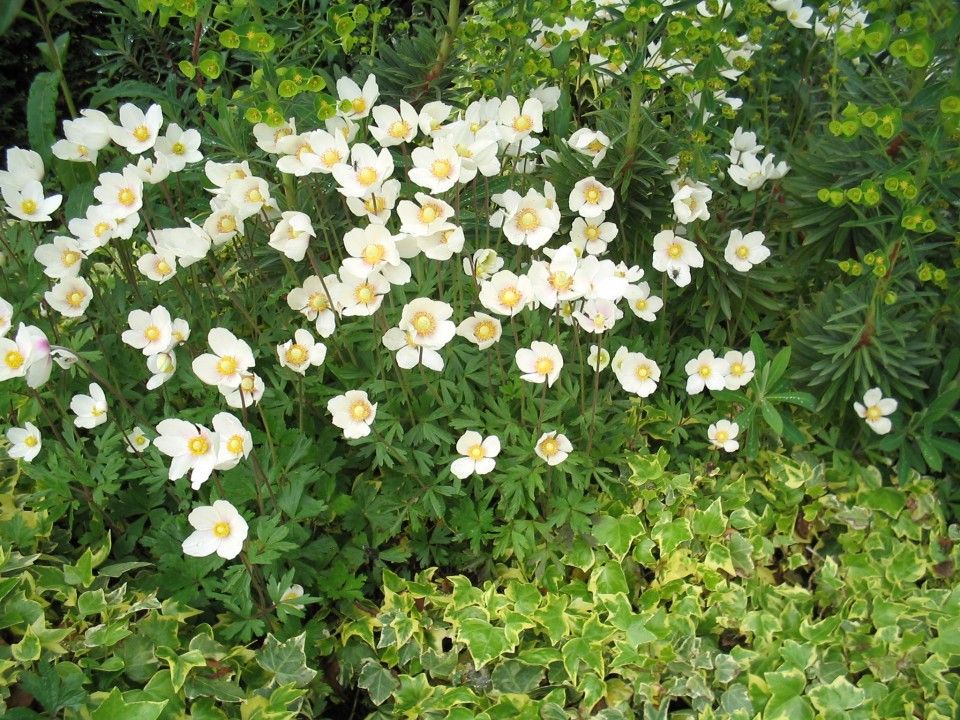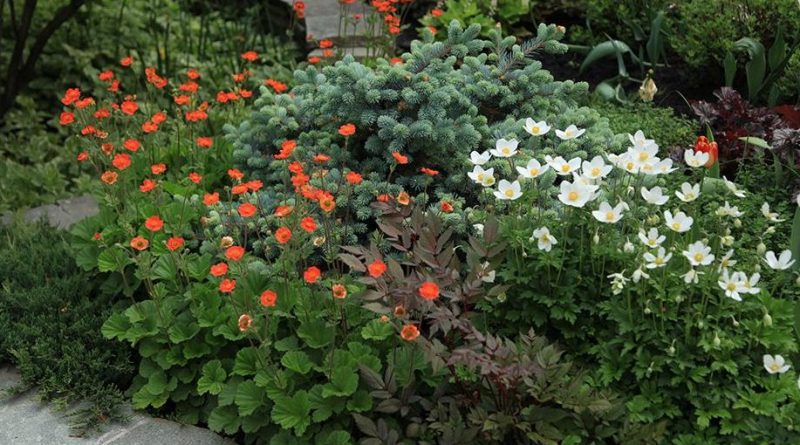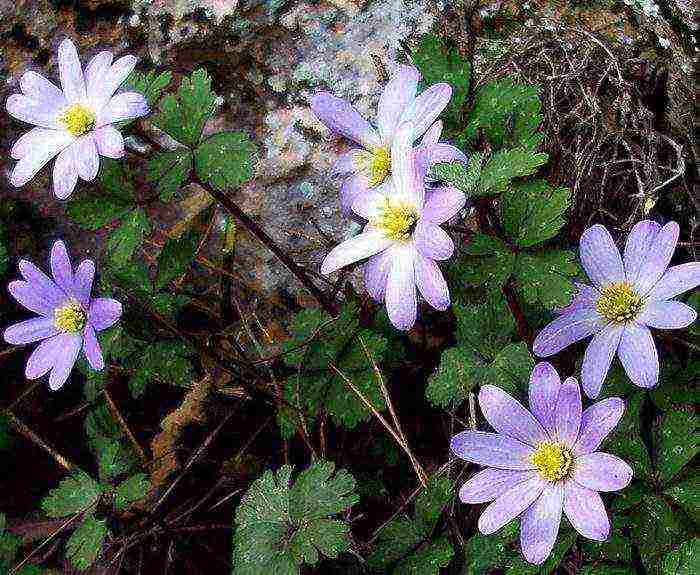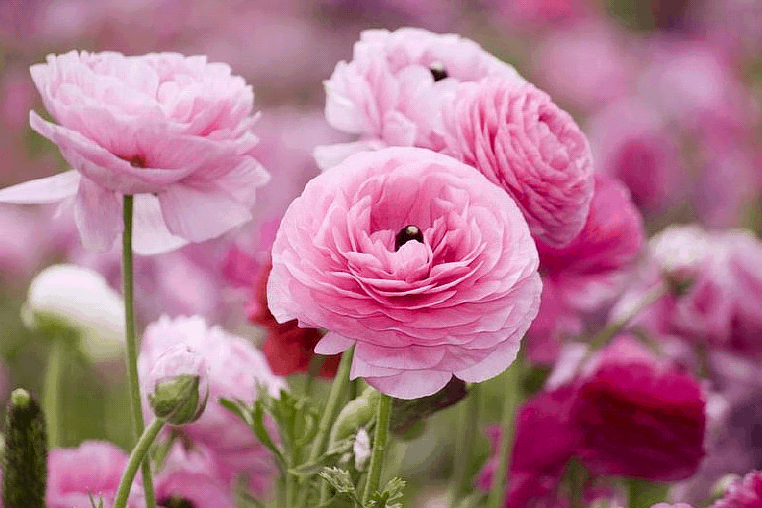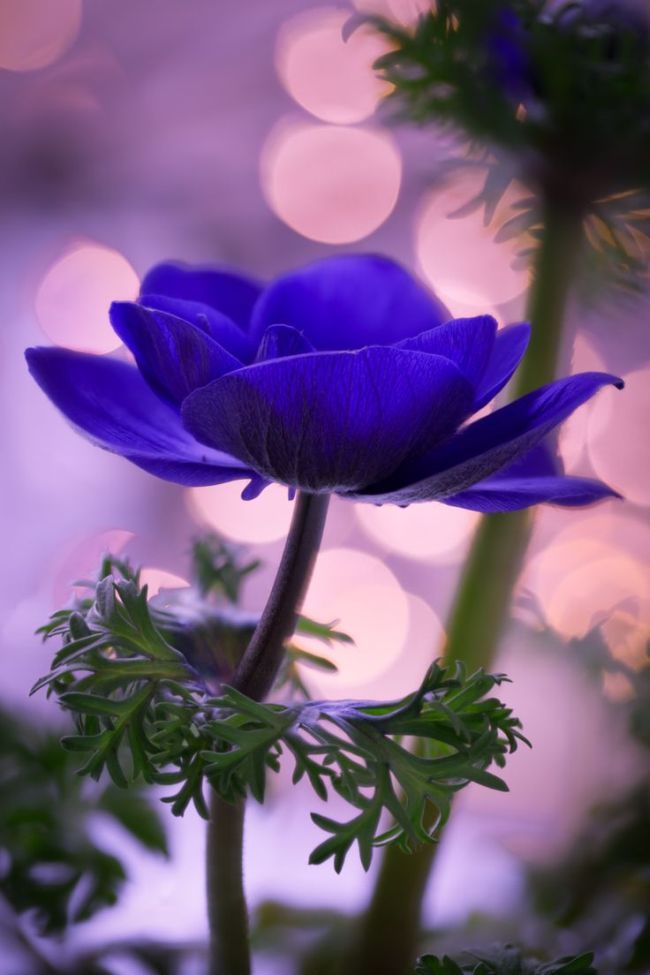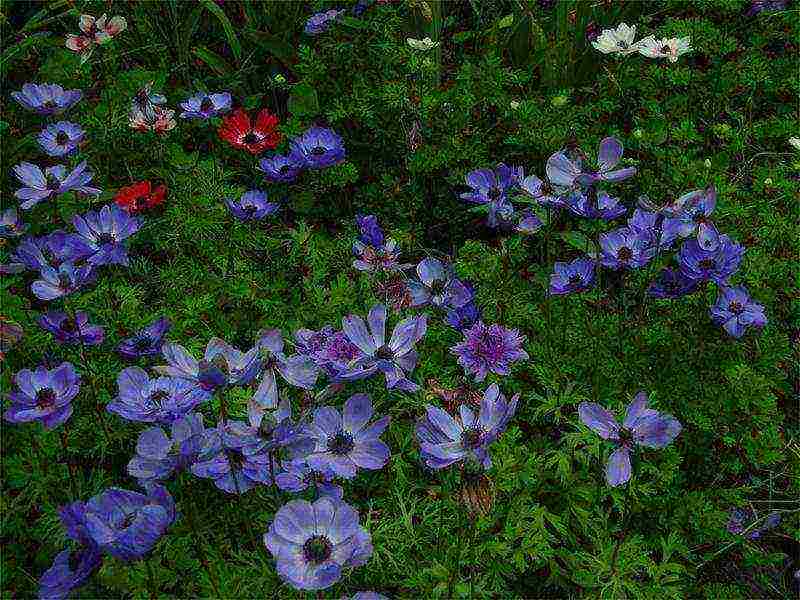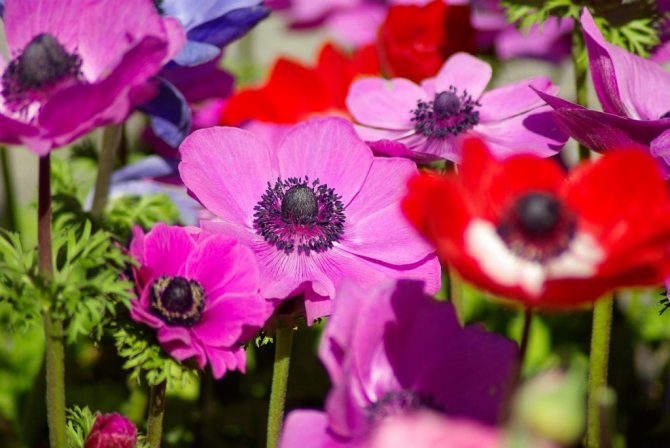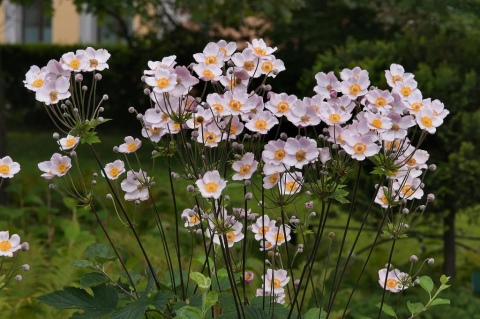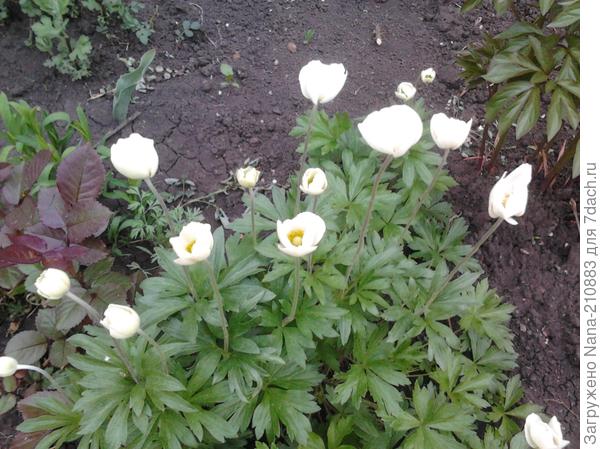Features of the autumn planting of anemones
Now let's take a closer look at how to plant anemones in the fall.
Preparing soil for anemone
Anemone grows well on loose, light, moderately fertile soil. Only forest anemone is capable of blooming on poor sandy soils. Although the plant needs abundant watering, stagnation of water at the roots is unacceptable. If you are planting an anemone on a slope, there will be no problem with this; in other cases, choose a site carefully. Arrange drainage if necessary.
Before planting anemones, dig up the soil well, remove pebbles and roots of weeds. Apply organic fertilizer as needed. Sour soil is not suitable for planting anemones. In order to correct the situation, add ash or dolomite flour for digging.
Preparing anemones for planting
It is best to plant freshly dug anemones in the fall. It is easy to do when moving. to another place grown on their own plot of anemones. But if you purchased the planting material in a garden center or on the market, it is better to soak the roots for several hours in epine, root or heteroauxin - this will significantly increase the survival rate.
Planting anemone
For planting anemones, choose a warm October day well before frost. The plant must have time to adapt to a new place. But still, do not expect that all anemones will survive the winter well, after all, autumn is not the best time to plant them in the ground.
The distance between the anemones depends on the size. Arrange them freely. Flowers growing in groups, for example, forest anemone, themselves form clumps over time. Handle fragile roots with care. If, before planting an anemone, you are going to dig it up in your own area, try to move the plant to a new place along with a clod of earth. This will significantly increase the chance of the anemone to survive the winter well and bloom next year.
Dig a shallow hole - the rhizome is buried by about 5 cm.If there is not enough humus, and you have not brought it in for digging, you can pour a handful directly into the hole and mix well with the ground. Be sure to water the anemone abundantly.
Caring for an anemone after planting
Caring for an anemone after planting consists in mulching the soil with peat or humus. If the autumn is warm, there is no rain, the soil must not be overdried. But it is also unacceptable to fill in the planting - there is a danger that the rhizome will rot.
In order to be able to check whether the anemone needs watering, moisten the entire soil in the garden, and not just the hole. Then it will be enough for you to dig a hole 10 cm deep next to the planted plants, take a handful of earth and squeeze it in your fist.
- If, when you open your hand, it is only slightly damp, and the soil is collected in a loose lump, there is enough moisture.
- A dry hand, the soil immediately crumbled - watering is needed.
- When squeezing a lump of earth, moisture oozes through the fingers - excess moisture.
Sowing anemone seeds
Can anemone seeds be sown in autumn? Do they sprout well? Often, even experienced flower growers fail to grow an anemone from seeds. In nature, the plant is most often bred vegetatively. Only a few ephemeroids and forest anemone reproduce by self-seeding.
Even freshly harvested anemone seeds sprout disgustingly, no more than 25%. But they still need to grow up to landing in a permanent place, and this is also not an easy task. The highest germination rate is given by late autumn crops.
Fill wooden crates with loose soil and bury them in a quiet area. Sow an anemone. For the winter, cover with spruce branches or cover with foliage.So the seeds will be stratified in natural conditions, and hardened seedlings will be easier to care for.
Preparing anemones for winter
Planting and caring for anemones in southern areas is always easier than where winters are harsh. It is enough to cover adult plants with a thin layer of leaves, peat or mullein. But with an autumn planting, such a shelter is suitable only for the south. In the middle lane, spruce branches, straw, and other mulch with a layer of at least 10 cm are used to insulate anemone that did not have time to take root well.
Important! In the spring, the shelter must be removed from the site so as not to interfere with the sprouts hatching
Types of anemone with photos and names
Both in natural conditions and in culture, a fairly large number of species and varieties of anemones grow. Below is a description of the most popular of them.
All types of flowering time are divided into spring and autumn (summer). Spring species are distinguished by their elegance and variety of colors, while they are painted in bed colors, for example: cream, blue, snow white, pink, lilac, etc. There are terry varieties.
Spring species are ephemeroids with a very short aerial flowering cycle. They wake up in April, amicable flowering is observed in May, while in July they begin a dormant period, while the foliage of most species does not fade until autumn.
Also, anemones are divided according to the type of rhizome, for example, the tender anemone has a slow-growing tuberous rhizome, and the oak and buttercup anemone has a jointed rhizome, which is distinguished by its fragility.
Anemone blanda
Such a miniature plant reaches a height of only 5 to 10 centimeters. The most popular varieties are: Blue Shades (blue), Charmer (pink), White Splendor (white).
Anemone nemorosa (Anemone nemorosa)
This species is relatively low in popularity among mid-latitude gardeners. The bush reaches a height of 0.2 to 0.3 m. Simple flowers have a diameter equal to 20–40 mm, as a rule, they are painted white, but there are varieties whose flowers have lilac, blue and pink colors. There are terry varieties. The main feature of this species is its unpretentiousness.
Anemone ranunculoides
This unpretentious species also has terry varieties. The bush reaches a height of 20 to 25 centimeters. The flowers are of a rich yellow color, somewhat smaller than those of the oak anemone. This species can be grown in almost any soil.
Autumn (summer) anemones include the following types: Japanese anemone (Anemone japonica), hybrid anemone (Anemone hybrida) and crown anemone (Anemone coronaria).
Most often these are large perennial plants with a well-branched powerful root system. Flowering is observed from the last summer weeks to mid-autumn. The flowering of the crown anemone is observed twice per season: in the first summer weeks and in autumn. Autumn species have slender and powerful peduncles, which reach 0.8–1 m in height, and there are several dozen semi-double or simple flowers of various colors on them. The most popular are the following varieties of crown anemones:
- anemone De Caen - simple single flowers of various colors;
- Mr. Fokker - the color of the flowers is blue.
Terry anemone has varieties such as Lord Jim with blue flowers and Don Juan with deep red flowers. Popular varieties of hybrid anemones are: Honorine Jobert - white flowers, slightly pink below; Profusion - dark purple semi-double flowers; Queen Charlotte - semi-double flowers of deep pink color. The most popular are the following varieties of Japanese anemones: Pamina - large double flowers are painted in a dark pink, almost burgundy color; Hadspen Abundance is a tall, cream-colored plant; Prinz Heinrich - semi-double color flowers deep pink.
Features and different kinds
As a rule, anemone is a spring flower, but there is also an autumn anemone; she is in no way inferior in beauty to her “relatives”. Among all autumn plants, the Japanese anemone stands out, striking with a riot of colors. Her flowers are white or pink with a golden center, surrounded by rich green leaves. Their flowering continues until October.
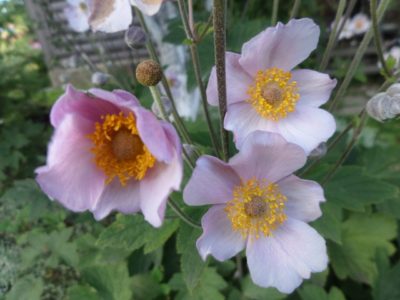
Japanese anemone loves light soil with peat, which has good water permeability. These flowers feel very good in partial shade, but they can grow on the sunny side, the most important thing is to protect them from gusts of wind.
When flowering ends, the plant's stems are shortened to the very ground; leaves at the roots are left and cut off only at the beginning of the next season.
Japanese anemone will be an excellent decor for your infield from July to October. It is tall, blooms for a long time, has very beautiful flowers, so it can be an ideal plant used for arranging flower beds. It will become a natural decoration for any corner of the garden.
The white anemone is considered an interesting enough variety, because it reproduces exclusively by seeds or by dividing the bush. This anemone is found with snow-white inflorescences, but now many varieties of it with different colors of petals have already been bred. Flowers can be simple or double.
The oak anemone has a fairly long and branched rhizome, which is why the flower grows very quickly, as a result of which real thickets are formed. If the flowers are not picked in time, then seeds are formed that sow the adjacent territory. The main advantage of this flower is considered to be unpretentious in care - it is enough only to periodically moisten the soil.
Beautiful and original anemone meadows amaze with their exquisite appearance, as they begin to break through even from under the snow. Anemone blanda is considered an interesting enough variety, which must be planted under large bushes, as they can protect from the wind, sultry sun and drying out of the soil.
This flower conquers with its beautiful and bright flowering, which is why it can become a real decoration of a garden or decorative flower bed; it is widely used in landscape design. With proper care, anemone flowers can delight you with their beauty for a long time.
Plant care
How many types, so many requirements for the parameters of lighting, humidity and soil. However, there are a number of conditions under which the flower feels comfortable, these are:
- small partial shade - suitable for forest species, the sunny side will be ideal for the Caucasian, Apennine, delicate and crown varieties;
- fertile enough loose soil - sand is used for this, it loosens well, drains and promotes air permeability;
- drainage components of the soil substrate, completely eliminating excessive moisture (a layer of broken brick or small stones), can be planted on a small elevation;
- there should be no drafts, although the name of the flower is translated from Latin as "daughter of the winds", but they have a destructive effect on it.
It is important to separately mention that they love the sun very much.
Watering
Anemones prefer abundant watering, but no standing water. If the correct structural composition of the soil is observed during planting, then the existing drainage will not allow the roots to be waterlogged.
In addition, to improve growth and flowering, you can create conditions for them similar to their natural ones. To do this, a layer of mulch is laid out on the ground near the plants, it can be in the form of compost, humus, loose peat, fallen leaves. This layer is renewed in spring and autumn.
Top dressing
Fertilizers need to be applied at planting and in the period before flowering. For these purposes, humus is suitable, during the laying of buds with liquid organic fertilizers. Complex mineral fertilizers are applied in autumn.You can buy them at any garden store.
The comprehensive care system includes regular loosening of the soil layer and weeding of weeds, and you need to pull out the weed with your hands, it is not recommended to use a hoe for these purposes, it can damage the fragile root system of the anemone.
Pests
Anemone is usually quite resistant to various types of diseases and pests. But, like all plants, it is susceptible to environmental influences.
The main pests are:
- leaf nematode - externally rusty spots, the fight consists in cutting off the leaves and renewing the upper soil layer under the bush;
- slugs, snails - containers filled with an aqueous solution of chlorine, metaldehyde diluted with water (the instructions can be read on the package) help; it is advisable to collect them manually before treating these pests with chemicals;
- winter worm (scoop) - water infusion of wormwood helps from it during the flowering period - pre-chopped raw materials (300 gr.), wood ash (glass), liquid soap (1 tablespoon) pour 10 liters of boiling water, cover and leave for about 6 hours, after cooling, spray.
In addition, aphids, thrips and whiteflies can be found. An aqueous mixture with the addition of simple laundry soap will help.
Capacity and soil for planting tuberous anemones
Planting and caring for flowers begins with the germination of the tubers themselves. As mentioned above, in order for the flowers to pick up buds faster, the tubers need to be germinated at home, in a pot, and ready-made plants should be planted in the ground.
The usual plastic and plastic containers for sprouting tubers will not work, since during transplantation the plant will have to be taken out of such a pot, and during this it is very easy to damage the root system of a young plant.
The ideal option here would be to use peat pots, which, together with the plant, are placed in the ground.
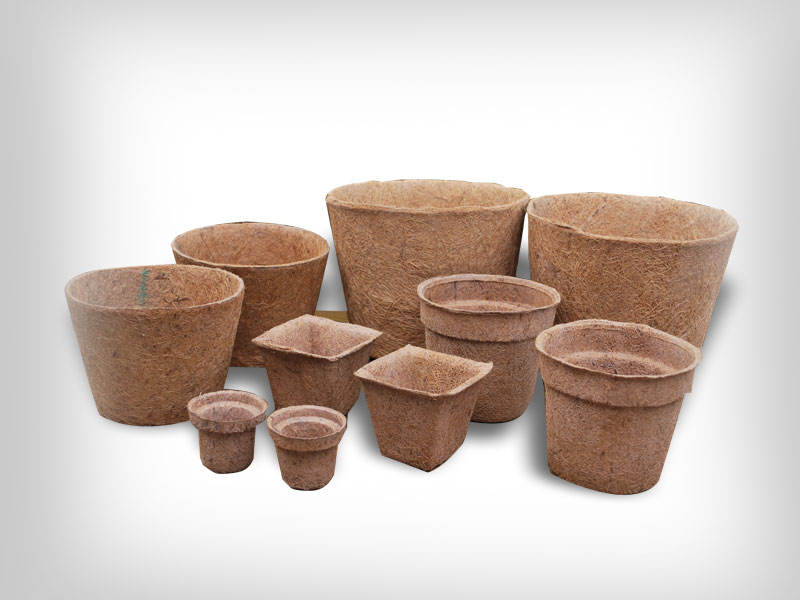
The soil for planting perennial anemones should be loose and alkaline - these are the best growing conditions. The soil is acidified with ash or dolomite flour. And to make the earth loose, you can add peat or coarse river sand to it.
Anemone - planting and care according to all the rules
The undoubted advantage of this plant is its unpretentiousness. Experts recommend growing it in loamy, loose, light, fertile soil.
The anemone, which is easy to plant and care for, does not do well in an excessively humid environment, so it is important to arrange a drainage system. It should be borne in mind that the anemone flower will grow over time, creating a kind of colonies
Transplanting negatively affects the condition of the plant, so this must be avoided and immediately provided with sufficient free space.
One anemone bush after 3-4 years occupies an area approximately equal to one square meter. Therefore, it is necessary to remove excess shoots while loosening the soil. A plant can live in the same place for more than five years. You can artificially limit the spread of the anemone by placing it in a container with a removed bottom. During spring and summer, the flower needs mineral and organic supplements, which should be given approximately twice a month. Fresh manure is contraindicated for the plant.
Do not forget that the flower loves to be in a bright place, but it cannot stand intense heat and direct sunlight. It is quite possible to grow in semi-shady places. The start time of flowering directly depends on the degree of illumination. In the case when the plant grows in a too dark place, you may not expect flowers from it at all. Experienced flower growers advise regularly watering anemones, while observing the measure. An overly wet plant will look bad and hurt.
Anemone - planting and care
Anemone flower: reproduction
Reproduction of anemones - by dividing the rhizome
Planting anemones in the ground is carried out in the spring or from late August to early September.Propagated by dividing the rhizome (in spring or autumn), seeds and root cuttings. When dividing the root of a bush, a place should be prepared for a new plant. Then the young parts of the flower - sprouts, adventitious buds, root, are delicately separated from the old plant, and then transplanted to a new place. The procedure should be carried out until March, because shoots will appear after it. For a successful transplant, it is recommended to choose a warm season, preferably spring.
Seed propagation
The seeds are light, fluffy. Immediately before disembarking, they are lightly rubbed with sand. It is sown in early spring (in March) in a bowl with drainage, filled with sandy-sod soil, and can be sown in May, in the soil of a cold greenhouse. It is not recommended to sow seeds densely, it is necessary to cover it with a very thin layer of earth, water after planting should be done very carefully, with a watering can with a thin, light stream.
Freshly harvested seeds, can be sown in the winter in the beds. Varietal varieties can be propagated by seeds that are planted in the soil immediately after harvest, preferably in winter. This will require wooden crates. The picking is carried out after the appearance of 2 leaves from the plant, you also do not need to forget about the thinning of the anemone flower. Anemone grown from seeds delight with flowering only in the third year of life.
transplant anemones
Planting seedlings
Seedlings dive into the garden or directly into the soil of a cold greenhouse, and then they are planted in the designated places. It is better to plant seedlings in place until the plant is one year old. With early spring sowing, the plants bloom in the first year, but reach full development only in the third year. Anemones blooming in early spring are planted to decorate lawns, massifs, parks, borders, next to shrubs and for cutting.
It is important to remember that an anemone, planting and caring for which does not require special knowledge, does not tolerate excessive interference in its life. In order for the plant to please with beautiful flowers, it is enough to carry out a number of simple operations and observe the measure in their actions.
The freedom-loving anemone can grow, gradually colonizing a tub or garden plot, so you should monitor its all-round growth.
Reproduction
Anemone reproduces in four ways:
- Seeds
- Part of the root
- By dividing the bush
- Tubers
Let's consider each in detail:
Seed reproduction
Anemone seeds have extremely poor germination. Only a quarter of them will germinate, provided they are fresh. Germination can be increased by stratification.

Anemone seeds
Step-by-step instruction:
- Refrigerate for 4-8 weeks. Mix them with peat or sand. Moisten well.
- Every day the mixture is checked and sprayed with water.
- After the seeds have swollen, the substrate is added. Re-moisturize abundantly.
- Transfer them to a well-ventilated place. The temperature must be maintained no more than 5 degrees.
- After the first shoots appear, they are buried in the ground or snow. From above, the planting must be covered with foliage or straw.
- After the emergence of seedlings, they are seated.
For those who find the process difficult, you can use the second method:
- In autumn, sow seeds in boxes with loose soil.
- Bury the boxes in the garden and cover this place with spruce branches.
- In the spring, they dig up and plant.
Thus, natural stratification takes place in winter. The first flowering occurs on average after 3 years. It depends on the variety. Some may bloom a year earlier, some later.
Reproduction by roots
Anemones with creeping roots can be propagated by dividing them:
- After the plant has faded, it is dug up.
- The roots are divided into segments. Each of which has a renewal bud. They usually form by the end of July. These buds are responsible for the growth and flowering of the plant for the next year.
- The segments are seated. They are insulated for the winter so as not to freeze.
In this way, you can propagate the Altai, Amur, smooth, oak, buttercup, Udi varieties. There are species of anemone capable of giving root suckers. These include forked, hybrid, canadian, forest anemones.

Anemone in natural habitat
Their roots give rise to offspring, it develops from the adventitious buds of the root system. It is recommended to harvest root cuttings in early spring or late summer. Such cuttings take root only 50%.
Step-by-step instruction:
- The plant is dug up.
- The roots are washed.
- The cut is made near the root collar.
- The plant is returned to the ground. It takes root during the growing season.
- The roots are cut into cuttings 5 cm long.
- They are planted in pots filled with loose soil mixed with peat and sand. The distance between the cuttings should be about 4 cm. The top of the cuttings should be sticking out of the ground.
- A layer of sand is poured on top, covered with a film or placed in a greenhouse. Watering should be done in moderation, otherwise the cuttings will start to rot.
- The film must be removed when green shoots appear.
- They are planted in open ground the next year.
Dividing tubers
Apennine, Caucasian, tender, crown anemones have tuberous roots. They can be propagated by dividing the tuber. Each separated part must have one or more buds.
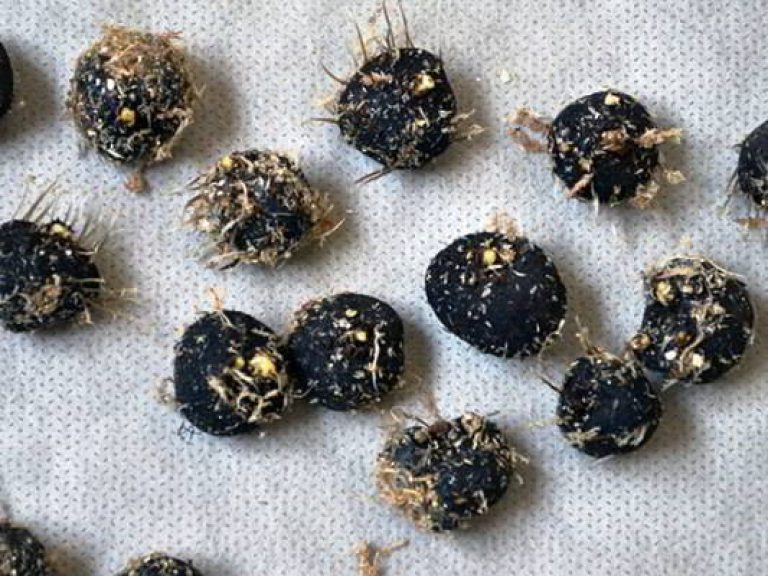
Anemone tubers
Division is carried out during dormancy of the plant. This period falls on the end of summer.
By dividing the bush
By dividing the bush, daffodil and long-haired species can be propagated. A prerequisite is a vertical root system.
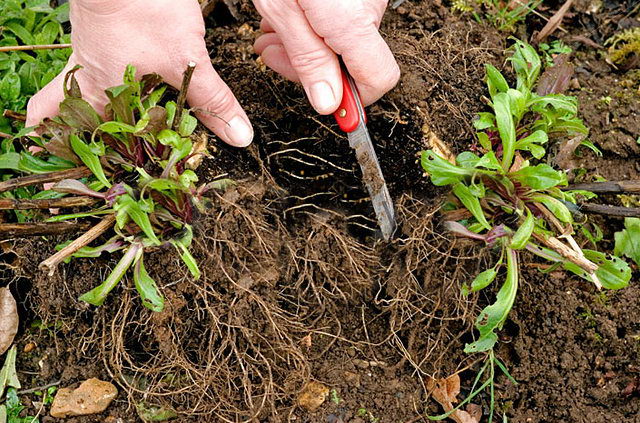
Dividing a bush plant
The bush is divided, each part must have a part of the root and bud. The separated parts quickly take root, they practically do not get sick.

How to make garden paths in the country with your own hands? (80+ Photo options for great ideas) + Reviews
Diseases and pests
The most common diseases are botrytis, or gray rot, root rot, oversporosis, rust, viral infections. Among the pests - aphids, slugs, scoops, leaf bugs, nematodes, bear. To reduce the risk of developing diseases and pests, it is necessary to regularly carry out the following measures:
- remove and destroy all plant residues;
- observe the watering regime, carry out regular loosening;
- avoid mechanical damage to plants during soil cultivation or cutting flowers;
- do not thicken the planting;
- strictly adhere to the alternation of crops in crop rotation, when re-using the substrate, steam or disinfect;
- carry out balanced feeding with a predominance of potassium and a moderate nitrogen content;
- maintain an optimal temperature and humidity regime in greenhouses, depending on the phase of plant development and illumination;
- to fight sucking pests - carriers of viral diseases.
Literature
1. Babunashvili V.V., Korobov V.I., Kozina V.V. Anemone crown - a valuable flower culture / V.V. Babunashvili, V.I. Korobov, V.V. Kozina // Gardening and viticulture of Moldova, 1986. - No. 11. - P. 17.
2. Visascheva L.V., Sokolova T.A. Industrial floriculture. - Moscow, Agropromizdat, 1991 .-- S. 275-280.
3. Forcing bulbous and bulbous flower crops. / Ed. IN AND. Bolgov. - Sochi, 2001 .-- S. 66-72.
4. Kozina V.V. Recommendations for growing early spring cuttings of crown anemones in greenhouses and film shelters without additional technical means of heating. - Sochi, 1998 .-- 16 p.
5. Kravtsov I.A., Evsyukova T.V., Kozina V.V. and other Recommendations for assessing the quality of flower products. - Sochi, 2009 .-- S. 14-21.
6. Kashcheeva Yu.P. Crown anemones. - Floriculture, 1961. - No. 5. - P. 22.
7. Kozina V.V. Anemone. / IN AND. Bolgov otv. editor. Sat. Uncommon flower cultures. - Sochi, 1998 .-- S. 13-19.
8. Krestnikova A., Kitaeva L. Anemones. / A. Krestnikova, L. Kitaeva - Flowers at any time of the year. - M .: "Moscow worker", 1974. - S. 31-43.
9. Razina E. and Razina A.Crown anemones near Moscow. / E. Razin and A. Razin. - Floriculture, 1972. - No. 8 - S. 26-27.
Photo by the author
Care
Anemone is an unpretentious plant, planting and caring for it is within the power of even a novice grower. However, in order for the flower to give lush flowering and not get sick, it is necessary to create optimal conditions for it for development.
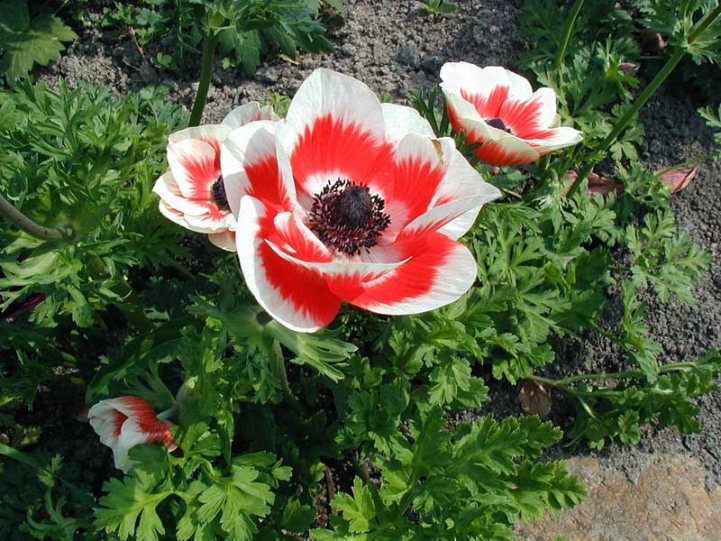
Location
When planting anemones in open ground, choose a shady area under the crown of trees or shrubs. In the sun, the petals will burn out and lose their bright colors.

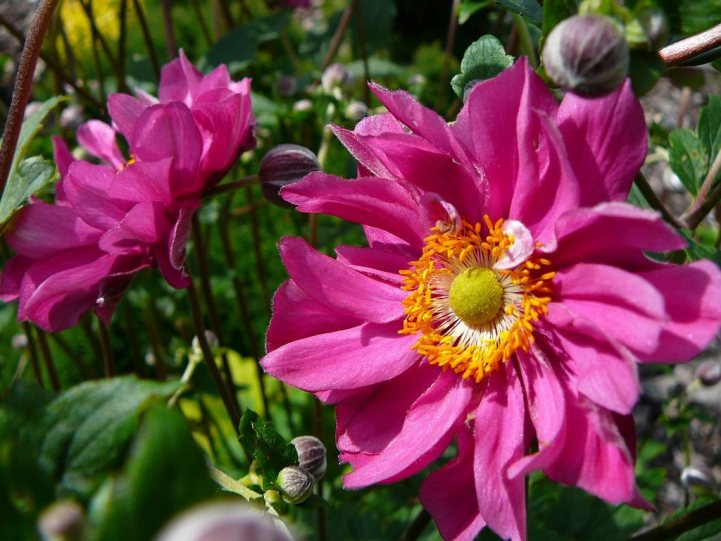
The soil
Before planting anemones, it is necessary to prepare the substrate in advance. It must be nutritious. Even a forest anemone, unpretentious to the ground, will bloom worse on poor land. The soil is fertilized with wood ash, compost, humus, manure.
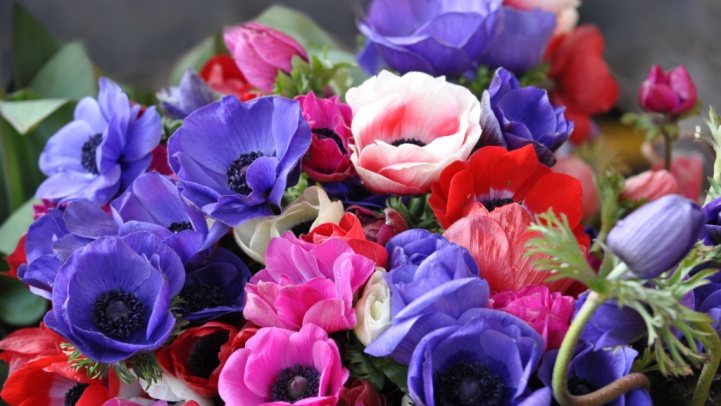
For the Apennine, crown, Caucasian anemones, an alkaline substrate is suitable. For other varieties, the soil should be neutral acidity.
Transfer
Adult specimens do not tolerate transplantation well. It should be done only when absolutely necessary. For example, with an infection in the soil, too dense planting.

The pick is made in early spring before flowering. Ephemeroid species can be transplanted in the summer after the inflorescence wilting.
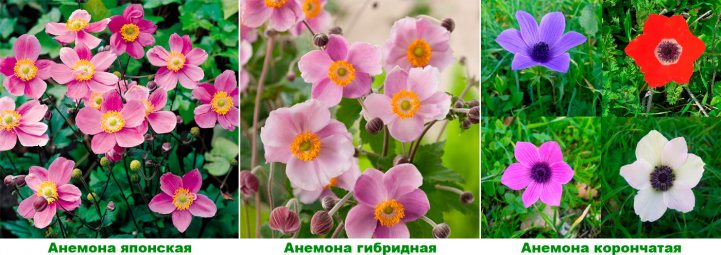
Mulching
This manipulation is mandatory. For mulching use:
- humus;
- peat;
- fallen leaves;
- decorative mulch.
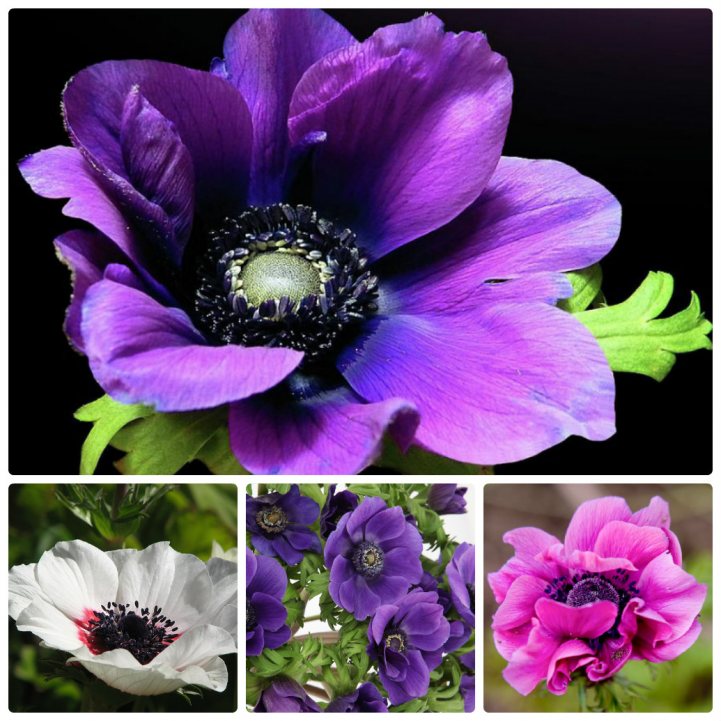
The layer should be about 5 cm. Mulch helps to retain moisture in the ground, prevents weeds.

Watering
Does not need regular hydration. The flower has enough natural precipitation.

In drought, daily watering is necessary. It is desirable to produce it in the morning or evening. Moisturizing under the sun during the day will evaporate the liquid. This will harm the anemone.

Top dressing
During the flowering period, organic fertilizers must be applied (with the exception of manure). Mineral mixtures are used in autumn. They nourish the root system before winter dormancy.

Wintering
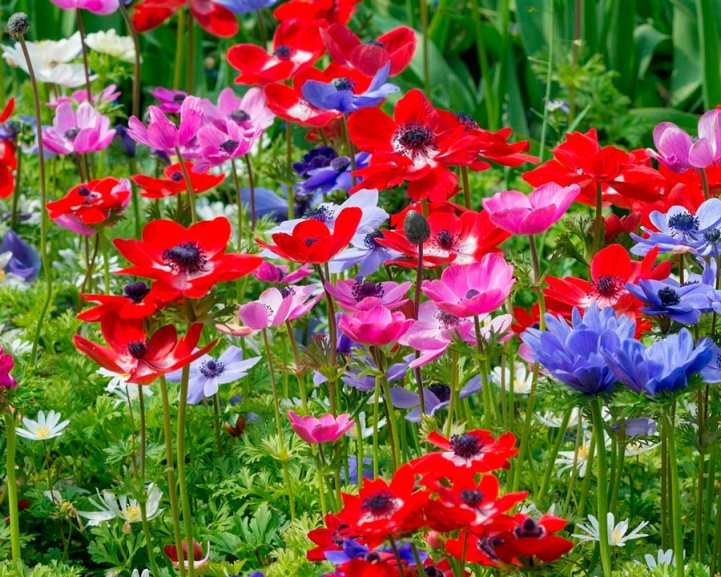
Crown anemone does not tolerate frosts. Its tubers must be dug up for the winter, dried at a temperature of + 20 ° C, put in boxes and kept at + 10 ° C for several weeks.
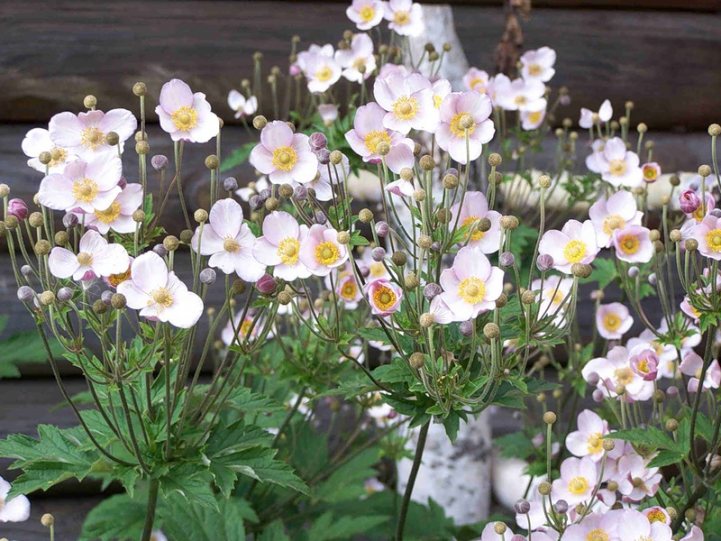
In winter, store tubers at a temperature of + 5 ° C, protect from drafts. The humidity in the room should be low. Experienced growers recommend keeping the bulbs in the sand.
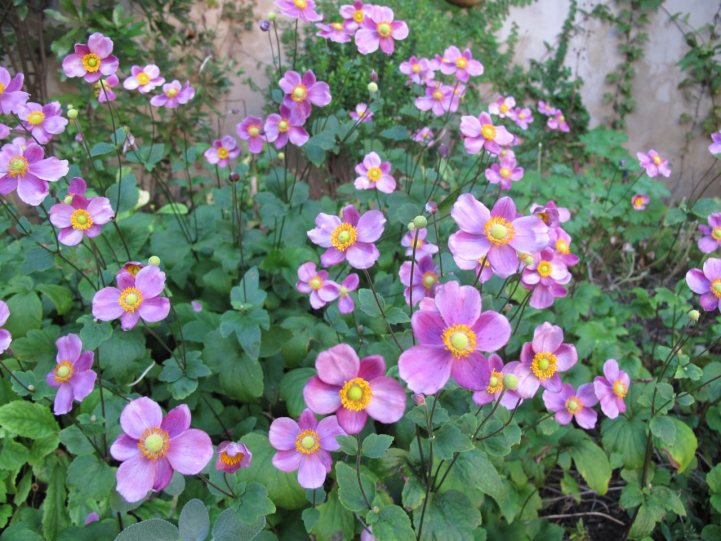
Diseases and pests
Japanese anemone is not a plant species with a weak immune system. However, they are not completely protected from the negative influence of the environment. Autumn anemones suffer from viruses that cause mosaicism, dwarfism, mutations - in this case, the plants must be destroyed.
Among the pests that threaten the Japanese anemone are the whitefly butterfly, whose larvae dry out the shoots, leaving yellow spots and mucous secretions on them. Also, the plant can be attacked by aphids and thrips, leaf nematodes - microscopic worms.
Quite often, the shoots are affected by gray rot - a fungus that spreads through the air. It provokes negative changes in tissues, interferes with photosynthesis, the leaves are covered with a bloom of mycelium. In a similar way, plants are affected by downy mildew. In this case, white spots appear on the top of the leaf plate, and a bloom of spores appears below.
Amazing flowers
The flowers of the beautiful anemones simply amaze with their variety of colors, species, each of which is unique and inimitable. Among all the varieties, the crown anemone stands out; she is considered the most real queen among all spring flowers. Its flowers are very similar to poppies, which is why they are often confused. In the center of the flower is a bunch of pistils and stamens, which are usually black. The petals of the anemone are large, brightly colored, however, unlike the poppy, the anemone has a wide variety of colors and shades, which is why in the spring it amazes with its riot of colors.
Anemone petals are classified into several different types:
- terry;
- semi-double;
- smooth.
Among all the varieties, the crown anemone of the Admiral variety can be distinguished. The difference between this flower is that on one bush there are many inflorescences with delicate semi-double petals. Anemone crown feels great in any flower beds next to other (almost all) plants. In order for the flower to feel good and delight with its abundant flowering, it is best to grow it in a semi-shaded and windless place. If you plan to use the anemone for further cutting, then you can grow it in the garden bed between vegetables. When creating a landscape design, you can place crown anemones in pots among rocky gardens, as they amaze with their unique flowering.
The crown anemone looks especially beautiful with neighbors such as daffodil or hyacinth. These will be the best neighbors for the anemones, because they look great, in addition, they are completely safe.
There is an opportunity to make a graceful composition with low-growing plants, in particular, with violets and forget-me-nots.

It should be borne in mind that it is better to touch the anemone with gloves, because the plant contains toxic substances that cause burns and irritation when it comes into contact with the skin.
It is worth noting that the anemone tolerates frost well, however, the plant must be protected in every possible way from the wind, which has a detrimental effect on it.
Growing anemones de Caen
For most gardeners, planting and caring for de Caenne tuberous anemone presents certain difficulties. This is partly due to the fact that anemones do not hibernate without digging. When purchasing tubers, we cannot be sure of their quality, and we ourselves make a lot of mistakes when sprouting. In addition, in cold regions, the crown anemone grown in the open field, especially if it bloomed for a long time, does not always have time to give a good bulb. Therefore, northerners often have to buy planting material of crown anemones over and over again, even with proper care.
Sprouting tubers
It is impossible to plant dry, shriveled tubers of crown anemone directly into the ground. First, they need to be soaked until they swell.
Important!
The most common mistake of flower lovers is that they completely submerge anemone bulbs in water. Tubers without oxygen access quickly "suffocate" and die, they cannot be germinated .. When growing anemones, crown roots are soaked in one of the following ways:
When growing anemones, crown roots are soaked in one of the following ways:
- Submerge the tubers in water half for 5-6 hours until they swell completely.
- Put a moistened cloth on the bottom of the container, place the anemone bulbs on top. This will take longer, but will reduce the likelihood of decay.
- Cover the roots of anemone with wet peat, sand or moss.
- Wrap the bulbs with a cloth moistened with water and wrap in cellophane.
Advice!
In order to increase the germination of anemone, add epin or heteroauxin.
Landing in the ground
After the tuber swells, you can plant anemones not only in the ground, but also in pots for preliminary germination. This is done if they want to receive flowers before the end of summer. From the moment the anemone tuber swells until the first buds appear, it can take about 4 months.
The site for the crown anemone should be well protected from the wind. In the northern regions, choose a sunny location, in the south - slightly shaded. Well-lit part of the day, flower beds placed near large trees or bushes with an openwork crown are well suited. They will protect the flower from the wind and create a light shade.
Planting soil anemones crown de caenne should be moderately fertile, loose, alkaline. If necessary, add humus to it and deacidify with dolomite flour, ash or lime. Where moisture stagnates, it is better not to plant an anemone. As a last resort, arrange a drain.
Flowers should be planted 5 cm deep, at least 15-20 cm apart.Tubers quickly spread horizontally fragile roots that do not like competition very much.
Planting crown anemones in autumn is possible only in greenhouses or containers.
Care during the growing season
Water anemone in hot, dry summer a little every day. Roots assimilate only the upper, fast-drying soil layer and cannot extract moisture from the lower soil layers. For the same reason, weeding anemones can only be done by hand, and loosening is generally excluded.
Cultivation of crown anemones, especially hybrids such as the de Caen variety series, requires regular feeding. Flowers, replacing each other, appear for a long time, they need food. At the beginning of the growing season, organic fertilizing with a high nitrogen content is carried out, during the laying of buds and their opening, the emphasis is on the mineral complex. Remember that anemones absolutely hate fresh manure.
Advice!
Immediately after planting, mulch the anemone with dry humus - this way you will reduce watering and weeding, besides, the rotted mullein will serve as an excellent fertilizer in the early stages of growth.
Digging and storage
When the flowering of the anemone is over and the aerial part is dry, dig up the tubers, rinse, cut off the remaining leaves and soak in a solution of foundationol or another fungicide for 30 minutes. Spread them out to dry in a thin layer and store at about 20 degrees until October. Then hide the anemone tubers in linen or paper bags, wet sand, moss or peat and keep at 5-6 degrees until the next season.
Reproduction
Crowned anemones are propagated by daughter bulbs. Of course, you can collect and sow seeds. But the sotoroseria de Caen is grown artificially, in nature such anemones are not found. After sowing, with which you are worn out due to poor germination (about 25% at best), after about 3 years, unremarkable anemone flowers will open, which do not repeat the maternal signs.

